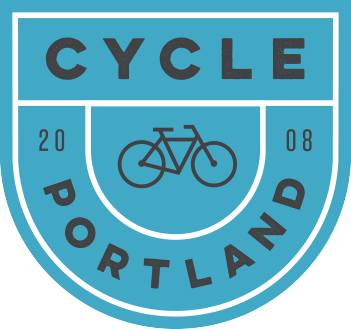It’s been raining here non stop for days and this time of year I see one or two other cyclists on my commute instead of a dozen or more. I manage to stay dry by winterizing my ride in the fall – adding fenders, making sure my tires are up to snuff and lights are bright, and replacing worn brake pads or cables. I also use a carefully picked assortment of rain gear and clothing layers to make up the ultimate protection system from the elements. (For me.) I really do believe that you have to find the system that works for you, and sometimes it takes a bit of trial and error.
In our climate, I wear long johns or some type of moisture wicking thermal base layer for a few months out of the year, both top and bottom. I avoid cotton socks and usually try and find a synthetic or wool blend. These materials will continue to keep you warm, even if they become wet. Cotton will not, and although I like the feel- I wear it at home. I layer my mid section with fleece in wet weather and down on dry only days. Layers that can be taken off with out much effort are a plus because it can be easy to overheat if you are to lazy to stop and peel one off.
I wear non insulated shell pants and jacket to protect from the rain and wind. My pants are full side zip so that I can take them on/ off without taking off my shoes (although the kind with just the ankle zipper will do just fine ). They fit over my regular work clothes and have their own pockets, so that I don’t have to un-do the clasp to get in to my jeans to get my keys just to lock my bike or something.

My jacket, like the pants it is made of a laminated waterproof/breathable material like Gore-tex or E-vent fabric and has pit-zips for ventilation. The hood is large enough to fit over my helmet (I often wear it under as well) and there are front pockets to keep my gloves if I need them. I like an elastic drawcord on the hood and the waist so that if I feel a draft I can put the kibosh on it. I also like velcro adjusting cuffs to lock in the glove cuff so that my wrist does not get exposed when making a hand signal. Bright colors are best.
Sometimes I wear a thin beanie under my helmet on really cold days. My helmet has a micro adjust on it, but if you are buying a new one, I always suggest imagining being able to ride with a thin hat or not when you are trying them on.
Gloves are a tough one and it is hard to find a good pair. Go for thin, waterproof/ breathable full finger gloves and try to get wind-stopper fabric and a padded palm. dexterity is important in gloves and they are sized by palm width not hand length.
I ride with clip-less pedals which is a strange name for pedals that do clip to the pedal with a cleat on the bottom of the shoe. I used a recessed cleat soft bottom shoe that is about as close to a street shoe as bike shoes get. I need to be able to carry my bike up an down stairs or manuver it on foot in a defensive traffic situation and I can’t be sounding like a tap dancer or feeling like I’m in high heels. I like shimano brand shoes, use what is called an “spd” pedal and cleat (the most common) and replace the laces with “shock cord” so that I don’t have to tie them ever. These shoes are not water proof so I use water proof socks that go over my regular socks. These work extremely well and are one of my favorite pieces of gear. You can get them for about $30 a pair at REI or EMS and you only need one pair. The shoes get wet, but your feet stay dry and warm.

When I ride with regular pedals I wear waterproof shoes or my xtratuf rubber boots and they work great. I have a shop space at work and there is space for me to keep a tote with an extra set of clothes, socks and shoes there just in case. I also keep a spare jacket there so that if it starts to rain during the day and I have forgotten my jacket, I will be covered.
Let us know if you have any special winter gear riding tips, we love to learn about new products and time tested techniques. Remember Bright Lights.
